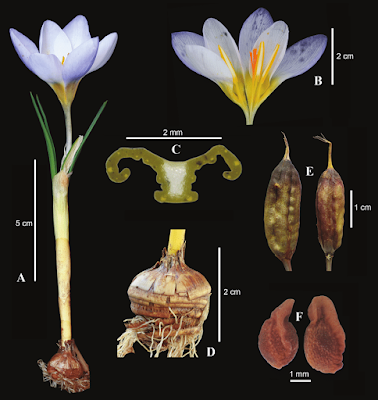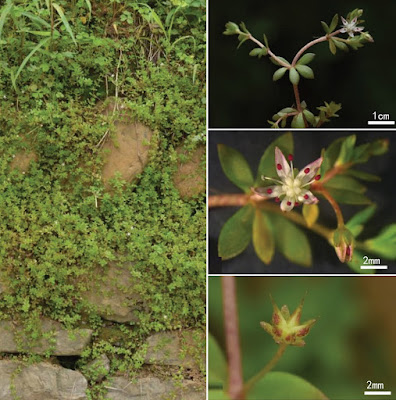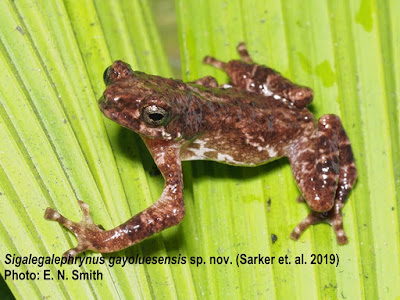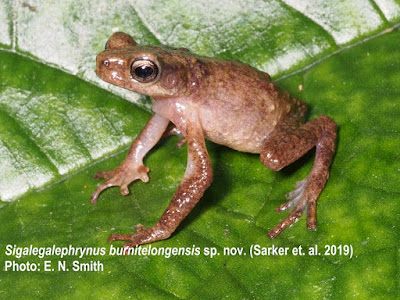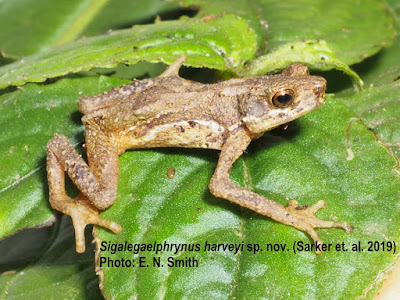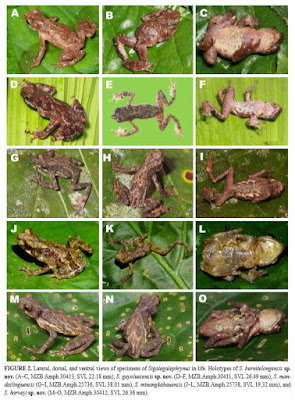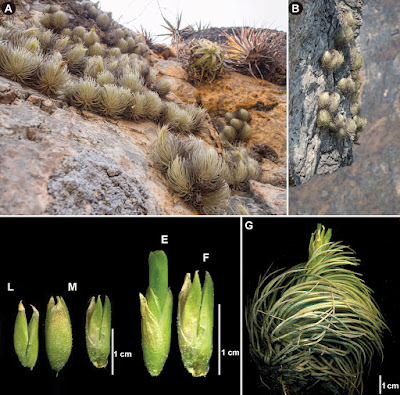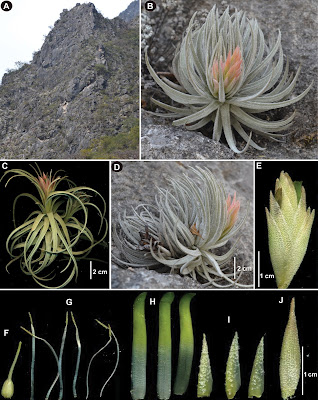[Most Recent Entries] [Calendar View]
Wednesday, October 2nd, 2019
| Time | Event | ||||
| 3:20a | [Botany • 2019] Crocus keltepensis (Iridaceae) • A New Crocus Species from the Highest Part of the Samanlı Mountains, North-western Turkey
Abstract Crocus keltepensis (Iridaceae) is described as a new endemic species from Kocaeli province in north-western Turkey. Diagnostic morphological characters, a full description, and detailed illustrations are given herein. Crocus keltepensis is distributed in a restricted area in the highest part of the Samanlı Mountains. According to its morphological features, it belongs to C. sect. Nudiscapus ser. Biflori. It shows morphological similarities with C. pulchricolor, which belongs to the same series. However, these two species are separated from each other by flower color, corm tunics, leaf and seed macromorphological characteristics. Keywords: endemic, geophyte, Keltepe, Turkish flora, Monocots
Crocus keltepensis Yüzb. sp. nov. Etymology:—The species epithet is derived from Keltepe, where the new species was discovered. Sırrı Yüzbaşıoğlu. 2019. Crocus keltepensis (Iridaceae): A New Crocus Species from the Highest Part of the Samanlı Mountains, NW Turkey. Phytotaxa. 418(2); 230–236. DOI: 10.11646/phytotaxa.418.2.8 | ||||
| 2:03p | [Botany • 2019] Sedum ichangensis (Crassulaceae) • A New Species from Hubei, China
Abstract Sedum ichangensis sp. nov., from Yichang, Hubei province, central China, is described and illustrated. The new species is similar to S. elatinoides and S. rosthornianum in its leaf and carpel morphology and differs in its creeping stems and solitary flowers. The conservation status of S. ichangensis was assessed as Endangered according to the IUCN Red List criteria. Keywords: Crassulaceae, Flora of China, Flora of Hubei, new species, Sedum sect. Filipes
Sedum ichangensis Y. B. Wang, sp. nov. Diagnosis: Sedum ichangensis has papillate carpels and appears to be morphologically similar to S. elatinoides and S. rosthornianum. It can be distinguished from S. elatinoides by its perennial habit (vs. annual) and solitary flower (vs. flowers in cymes) and from S. rosthornianum in its entire leaf margins (vs. leaf margins dentate), its branched stems (vs. stems simple) and its solitary flowers (vs. flowers in paniculiform cymes). Distribution and habitat: Sedum ichangensis is known from Longzhouping town of Changyang County, Gufu town of Xingshan County and Muyang River of Yiling County in Yichang City of western Hubei Province, central China (Fig. 3). It grows on rocks of roadsides, especially in fissures filled with soil, at an elevation of ca. 100–280 m. Etymology: The specific epithet of this new species is dedicated to the Yichang city. Chinese name: Yi-chang-jing-tian (宜昌景天). Yu-Bing Wang and Xing-Jun Xiong. 2019. Sedum ichangensis, A New Species of Crassulaceae from Hubei, China. PhytoKeys. 132: 91-98. DOI: 10.3897/phytokeys.132.35428 | ||||
| 3:22p | [Herpetology • 2019] Sigalegalephrynus spp., the Puppet Toads (Anura: Bufonidae) of Sumatra • New Species, Diversity, Systematics, and Conservation Assessment
Abstract Using a combination of morphological and molecular data we recognize three new species of Puppet Toad, Sigalegalephrynus Smart, Sarker, Arifin, Harvey, Sidik, Hamidy, Kurniawan & Smith, a recently described genus endemic to the highland forests of Sumatra, Indonesia. Phylogenetic analysis of mitochondrial DNA sequences recovered a monophyletic relationship among all Puppet Toads, with two distinct evolutionary clades, a northern and a southern. The northern clade includes Sigalegalephrynus gayoluesensis sp. nov., and S. burnitelongensis sp. nov., and the southern clade includes S. harveyi sp. nov., S. mandailinguensis, and S. minangkabauensis. With the discovery of these three new species, Sigalegalephrynus contains more endemic species than any other genus of toad in Indonesia. We used maximum entropy, implemented in MaxEnt, to identify suitable habitats and occurrence probability of additional undescribed new species from the island. The most important predictors of Sigalegalephrynus distribution were elevation (64.5%) and land cover (7.11%). Based on the probability of presence, it is likely that there are many more species of the genus awaiting discovery in Sumatra. Our analysis, based on IUCN Red List of Threatened Species category and criteria, shows that all of the five species of Sigalegalephrynus are in great risk of extinction and should be placed into the Endangered (EN) category of IUCN Red List. Keywords: Chordata, GeoCAT, Indonesia, IUCN Red List, MaxEnt, Niche modeling, Sigalegalephrynus burnitelongensis sp. nov., Sigalegalephrynus gayoluesensis sp. nov., Sigalegalephrynus harveyi sp. nov., Sigalegalephrynus mandailinguensis, Sigalegalephrynus minangkabauensis, Southeast Asia, Sunda Shelf Goutam C. Sarker, Elijah Wostl, Panupong Thammachoti, Irvan Sidik, Amir Hamidy, Nia Kurniawan and Eric N. Smith. 2019. New Species, Diversity, Systematics, and Conservation Assessment of the Puppet Toads of Sumatra (Anura: Bufonidae: Sigalegalephrynus). Zootaxa. 4679(2); 365–391. DOI: 10.11646/zootaxa.4679.2.9 | ||||
| 5:36p | [Herpetology • 2019] Novelties in the Genus Viridantha Espejo (Tillandsioideae, Bromeliaceae); Viridantha uniflora & V. secundifolia
Abstract Based on morphological evidence, we propose to raise Tillandsia mauryana forma secundifolia to species level with the name Viridantha secundifolia (Ehlers) Hern.-Cárdenas, Espejo & López-Ferr. Viridantha secundifolia can be readily distinguished by the falciform rosettes, the broadly oblong to square, 1–1.2 × 0.8–1.1 cm leaf sheaths and by the 1.8–2 × 0.7–1.2 cm floral bracts. Additionally, we describe and illustrate Viridantha uniflora Hern.-Cárdenas, Espejo & López-Ferr., from the state of Oaxaca, Mexico. The new species is morphologically similar to Viridantha boqueronensis, but differs by the nearly square leaf sheaths, 1.3–1.5 × 0.4–0.5 cm spikes and by the presence of only one flower per spike. A key to the taxa, morphological descriptions, list of specimens examined, illustrations and a distribution map of the described taxa are included. Keywords: Hidalgo, México, Oaxaca, Tillandsia, Viridantha Viridantha uniflora Hern.-Cárdenas, Espejo & López-Ferr., sp. nov. Diagnosis: Viridantha uniflora is similar to V. boqueronensis but differs in the shape (square vs. ovate to triangular) and the width of the leaf sheath (0.7–0.8 cm vs. 1 cm); the width (0.4–0.5 cm vs. 0.7–1.3 cm) of the spikes, the number of flowers per spike (always 1 vs. 2–5); and in the shape of the floral bract (ovate vs. elliptic). ... Habitat and ecology: Viridantha uniflora is only known from the boquerón of the Santos Reyes Tepejillo municipality, located in the Sierra Madre del Sur in the northwest region of the state of Oaxaca, where it grows on vertical walls in dry oak forests and tropical deciduous forests. The plants of V. uniflora grow in colonies, between 1700 and 1900 m a.s.l., on the cliffs of the boquerón amongst other saxicolous herbs. (Figs 2, 3). Phenology: The plants of Viridantha uniflora bloom in April and May. Etymology: The specific epithet refers to the presence of one flower per spike, condition only known in the proposed taxon. Viridantha secundifolia (Ehlers) Hern.-Cárdenas, Espejo & López-Ferr., comb. et, stat. nov. Basionym: Tillandsia mauryana L.B. Sm. forma secundifolia Ehlers, Die Bromelie. Sonderheft 6: 56–60. Figs pp. 56, 57, 60. 2009. Habitat and ecology: Viridantha secundifolia is only known from the state of Hidalgo in the western and eastern regions of Metztitlán and Tolantongo municipalities, respectively, where it grows on vertical walls in xerophilous scrubs at elevations between 1100 and 1900 m a.s.l. (Figs 1, 2). Rodrigo Alejandro Hernández-Cárdenas, Alejandra Serrato Díaz, Ana Rosa López-Ferrari and Adolfo Espejo-Serna. 2019. Novelties in the Genus Viridantha Espejo (Tillandsioideae, Bromeliaceae). PhytoKeys. 132: 99-110. DOI: 10.3897/phytokeys.132.36959 Resumen: Con base en evidencia morfológica, proponemos elevar a nivel de especie a Tillandsia mauryana forma secundifolia con el nombre Viridantha secundifolia (Ehlers) Hern.-Cárdenas, Espejo & López-Ferr. Viridantha secundifolia puede distinguirse fácilmente por las rosetas falciformes, las vainas foliares ampliamente oblongas a cuadradas, de 1–1.2 × 0.8–1.1 cm y por las brácteas florales de 1.8–2 × 0.7–1.2 cm. Además, se describe e ilustra Viridantha uniflora Hern.-Cárdenas, Espejo & López-Ferr., del estado de Oaxaca, México. La nueva especie es morfológicamente similar a Viridantha boqueronensis pero difiere por las vainas foliares cuadradas, la espigas de 1.3–1.5 × 0.4–0.5 cm y por presentar una sola flor por espiga. Se proporciona una clave de identificación, descripciones morfológicas, lista de ejemplares examinados, ilustraciones y un mapa de distribución de los taxa descritos. |
| << Previous Day |
2019/10/02 [Calendar] |
Next Day >> |
